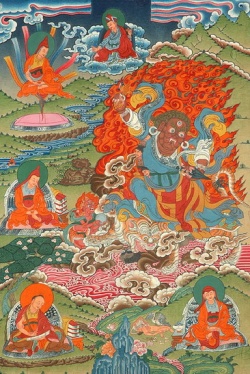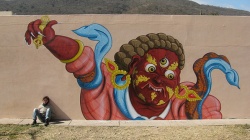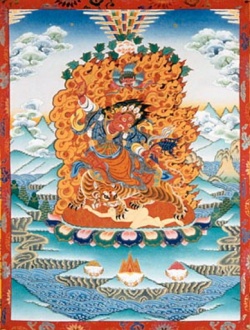Guru Padmasambhava as Dorje Drolo who Took Buddhism to Bhutan
Padmasambhava was a great yogi, originally from Swat Valley of northwest region of modern Pakistan. He was invited to Tibet by the Tibetan king Trisong Detsen (8th century A.D.) and the famous Buddhist acharya Shantirakshita to help in the establishment of Buddhism in Tibet. Padmasambhava helped them in the establishment of Samye monastery in Tibet.
He tamed many local deities and initiated Tantric Buddhist teachings in Tibet. He is said to have subdue all the malignant gods, sparing only those that became converted to Buddhism and that promised to be defenders of the doctrine.
Padmasambhava, in his turn, promised to enroll them in the Mahayana Pantheon and to see that they were properly worshipped. He thus succeeded assimilating parts of local Bon religion into Vajrayana Buddhism. Padmasambhava claimed to have received from the Dakini the books from which he acquired his miraculous powers. Padmasambhava is regarded as a major spiritual ancestor of all Tibetan Buddhists in general and the father of the Nyingma sect in particular.
Tibetans usually call him Guru Rinpoche, or Precious Teacher with reverence and consider him as a second Buddha. He founded Lamaism in Tibet. In course of time Padmasambhava was deified and incarnated into eight forms, one for each of eight important actions he performed during his lifetime. The eight manifestations of Padmasambhava are as follows:
1. Vajradhara or Mahavajradhara
2. King Padmaraja
3. King Loden Chogsay
4. Suryaprabha (Nyima Odzer)
5. Dorjeyy Drolod (In this form he introduced Buddhism in Bhutan)
6. Guru Dradog
7. Padmasambhava as a Nyingma monk
8. Shakya Senge (Lion of the Shakya Clan).
As mentioned above, one of the forms of Padmasambhava is Dorjey Drolod. It is said that Padmasambhava took this form at the Tiger's Lair (Tagtsang) cave in Bhutan in order to subdue demons that were troubling the people of Bhutan. Guru flew there mounted on the back of his consort, the Mon princess Tashi Kyidren, who transformed herself into flying tigress and subdues the demons and negative forces of Bhutan. In this way Padmasambhava also brought Buddhism to Bhutan where he is still much venerated today.
Padmasambhava is shown here as a stocky figure with a brown body. He holds a vajra and a phurpa. His expression is wrathful. He rides, as mentioned above, a tigress, which tramples a body over the ocean of blood. Guru is wrapped in heavy, expensive robes, and wears a garland of severed human heads, earrings and bracelets. The vigor of the bold flame pattern serves, on his back to enliven and add force to the image.
In the top centre perhaps Padmasambhava is seated in his usual form in clouds. The top left depicts a meditating yogi lama, above his seat in rainbow light, perhaps practicing a higher level of yoga.
Below in the left region a lama is on a cushion with scriptures. The bottom left depicts a commentary writing lama, while the lower right corner is filled with the figure of a meditating lama.
The bottom ce4ntre depicts rocks with flowers and charnel ground. The central figure is surrounded with green mountainous landscape with natural vegetation and blue lakes etc. The painting is very much suitable for the ritual, sadhana and practices of Rinpoche.
This description is by Dr. Shailendra K. Verma. His Doctorate thesis being: "Emergence and Evolution of the Buddha Image (From its inception to 8th century A.D.)".


